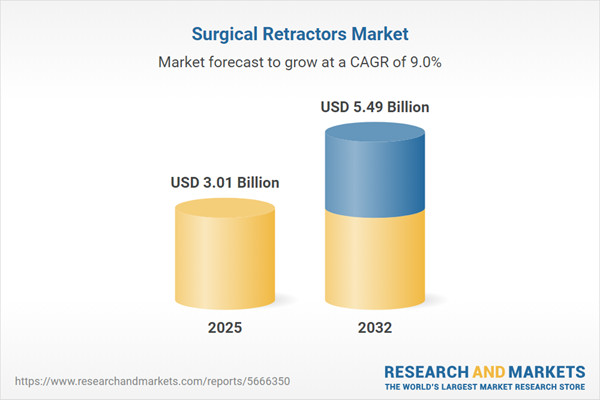Speak directly to the analyst to clarify any post sales queries you may have.
The surgical retractors market is evolving in response to rising procedural complexity, stricter regulatory standards, and demand for precision-driven, efficient surgical tools. Senior decision-makers face growing pressure to adapt product portfolios and sourcing strategies to stay ahead in a rapidly changing healthcare environment.
Market Snapshot: Growth Dynamics and Key Trends
The surgical retractors market, valued at USD 2.76 billion in 2024 with a projected CAGR of 8.95%, is set to reach USD 5.49 billion by 2032. Demand is fueled by increasing adoption of minimally invasive surgeries, ongoing advancements in materials and device design, and the integration of digital technologies within operating rooms. Emerging regulatory frameworks and supply chain challenges are simultaneously shaping sourcing, pricing, and innovation initiatives across the industry.
Scope & Segmentation: Product, Technology, and Regional Coverage
- Product Types: Handheld retractors serve as versatile instruments for general and orthopedic surgery. Self-retaining models, such as Gelpi and Weitlaner retractors, provide hands-free stabilization, while table-driven systems like Bookwalter and Finochietto (manual and pneumatic rib spreader) ensure optimized exposure for complex procedures.
- Material Types: Stainless steel dominates for its durability and corrosion resistance. Titanium is increasingly preferred where lightweight properties and radiolucency are needed. Plastic, largely for single-use settings, addresses infection control through sterilization avoidance.
- End Users: Market adoption is diversified among ambulatory surgical centers, clinics, hospitals, and research institutes, each seeking unique attributes such as setup efficiency, reusability, and compatibility with advanced teaching protocols.
- Applications: Specialties such as cardiovascular, general surgery, neurology, and orthopedics each drive distinct innovation in retractor design, from low-profile, adjustable blades to robust systems capable of withstanding high-torque manipulation.
- Sales Channels: Distribution is managed through direct sales, third-party distributors, online sales platforms, and retail pharmacy channels, influencing pricing models and after-sales support.
- Regional Focus: Coverage includes the Americas (United States, Canada, Mexico, Brazil, Argentina, Chile, Colombia, Peru), EMEA (United Kingdom, Germany, France, Russia, Italy, Spain, Netherlands, Sweden, Poland, Switzerland, United Arab Emirates, Saudi Arabia, Qatar, Turkey, Israel, South Africa, Nigeria, Egypt, Kenya), and Asia-Pacific (China, India, Japan, Australia, South Korea, Indonesia, Thailand, Malaysia, Singapore, Taiwan).
- Leading Companies: Assessed organizations include Johnson & Johnson, Medtronic plc, Stryker Corporation, B. Braun Melsungen AG, Zimmer Biomet Holdings, Inc., Smith & Nephew plc, Teleflex Incorporated, CONMED Corporation, NuVasive, Inc., and Integra LifeSciences Holdings Corporation.
Key Takeaways for Senior Decision-Makers
- Technological advancements are enabling real-time data integration, automated tissue handling, and ergonomic innovations to improve surgical outcomes.
- Collaboration among engineers, surgeons, and academic institutions is accelerating the pace of retractor customization for specialty procedures and supporting adaptive modular platforms.
- Regional manufacturing initiatives and near-shoring strategies are becoming critical to reduce supply chain risk, cut lead times, and improve cost efficiencies in light of evolving trade landscapes.
- Regulatory convergence across markets is streamlining device approval but raising performance and safety expectations that require investment in R&D and compliance.
- Segment diversity in product type, materials, and user preference is stimulating ongoing differentiation, shaping both product lifecycle and after-market service offerings.
Impact of 2025 Tariff Policies on Supply Chain and Sourcing
Recent tariff measures, implemented in 2025, have affected landed costs and procurement strategies for global surgical retractor stakeholders. Many organizations are diversifying supplier portfolios, localizing key production, and entering long-term agreements with domestic partners to offset price pressures. These adaptive approaches are critical for operational resilience and transparency.
Market Research Methodology & Data Integrity
This study incorporates robust, multi-stage research, beginning with expert interviews across surgical, procurement, and R&D domains. Secondary sources include peer-reviewed journals, regulatory databases, and industry white papers. Insight validity is maintained through data triangulation, cross-referencing, and external peer review to uphold analytical rigor.
Why This Report Matters for Decision-Makers
- Gain timely guidance on device innovation, sourcing dynamics, and competitive positioning in a fast-evolving surgical environment.
- Leverage actionable insights to develop resilient supply chain models, strengthen stakeholder partnerships, and maximize return on R&D investment.
Conclusion
Surgical retractor market leaders that prioritize innovation, supply chain agility, and cross-disciplinary collaboration will deliver greater value and maintain relevance in an increasingly competitive landscape. Informed actions today set the foundation for procedural excellence tomorrow.
Additional Product Information:
- Purchase of this report includes 1 year online access with quarterly updates.
- This report can be updated on request. Please contact our Customer Experience team using the Ask a Question widget on our website.
Table of Contents
3. Executive Summary
4. Market Overview
7. Cumulative Impact of Artificial Intelligence 2025
List of Figures
Samples

LOADING...
Companies Mentioned
The key companies profiled in this Surgical Retractors market report include:- Johnson & Johnson
- Medtronic plc
- Stryker Corporation
- B. Braun Melsungen AG
- Zimmer Biomet Holdings, Inc.
- Smith & Nephew plc
- Teleflex Incorporated
- CONMED Corporation
- NuVasive, Inc.
- Integra LifeSciences Holdings Corporation
Table Information
| Report Attribute | Details |
|---|---|
| No. of Pages | 195 |
| Published | October 2025 |
| Forecast Period | 2025 - 2032 |
| Estimated Market Value ( USD | $ 3.01 Billion |
| Forecasted Market Value ( USD | $ 5.49 Billion |
| Compound Annual Growth Rate | 8.9% |
| Regions Covered | Global |
| No. of Companies Mentioned | 11 |









